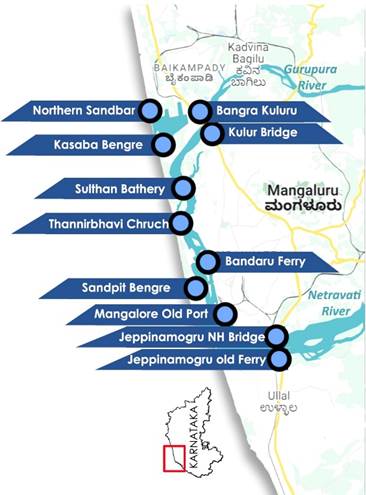SAGARMALA PROJECT
1. Context
Under the ambit of Sagarmala, the Ministry of Ports, Shipping and Waterways has provided in-principle approval to 4 additional projects in Tamil Nadu and Karnataka.
2. Key Points
- Several Reforms and initiatives in the maritime industry to strengthen the country's socioeconomic and regulatory environment.
- One of the key initiatives of the Ministry is to promote and develop a unique and innovative concept of floating jetties ecosystem which when compared to traditional fixed jetties, offers several advantages, such as being environmentally friendly having a longer shelf life and modular construction.
3. Floating jetty projects
- There are a total of 11 floating jetty projects in Karnataka. These projects are located primarily on the Gurupura River and Netravati River and shall be used for tourism purposes. The other locations are Thannir Bhavi Church, Bangra Kuluru, Kulur Bridge and Jappina Mogaru NH bridge.
- Additionally, Ministry has provided in-principle approval to 4 floating jetty projects in Tamil Nadu.
- The projects at Agni Thertham and Villoondi Theertham are located in Rameshwaram which is a renowned spiritual place in India. Additionally, projects are located at Cuddalore and Kanyakumari and cater to tourists at these distinguished tourist destinations.
- These projects will assist in offering safer, hassle-free transportation to tourists and will lead to overall development and upliftment of the coastal community.

Image Source: PIB
4. About the Sagarmala project
- The concept of Sagarmala was approved by the Union Cabinet on 25th March 2015.
- As part of the programme, a National Perspective Plan (NPP) for the comprehensive development of India's 7, 500 km coastline, 14, 500 km of potentially navigable waterways and the maritime sector has been prepared which was released by the Hon'ble Prime Minister, on 14th April 2016 at the Maritime India Summit 2016.
5. Port-Led Development
- India is one of the fastest-growing large economies in the world with a GDP growth rate of 7.3 per cent in 2018-19 and ports play an important role in the overall economic development of the country.
- Approximately 95 per cent of India's merchandise trade (by volume) passes through seaports.
- Many ports in India are evolving into specialized centres of economic activities and services and are vital to sustaining the future economic growth of the country such as JNPT, Mundra Port, Sikka Port, Hazira Port etc.
- However, Indian ports still have to address infrastructural and operational challenges before they graduate to the next level.
- For example, the operational efficiency of Indian ports has improved over the years but still lags behind the global average.
- Turnaround time (TAT) at major ports was approximately 2.5 days in 2018-19, whereas the global average benchmark is 1-2 days.
- Some of the private sector ports in India like Mundra and Gangavaram have been able to achieve a turnaround time of around 2 days.
- Secondly, last-mile connectivity to the ports is one of the major constraints in the smooth movement of cargo to/from the hinterland.
 Image Source: PIB
Image Source: PIB- Around 87 per cent of Indian freight uses either road or rail for the transportation of goods.
- A significant share of this cargo experiences "idle time" during its transit to the ports due to capacity constraints on highways and railway lines connecting ports to production and consumption centres.
- Although water-borne transport is much safer, cheaper and cleaner, compared to other modes of transportation, it accounts for less than 6 per cent of India's modal split.
- By comparison, coastal and inland water transportation contribute to 47 per cent of China's freight modal mix, while in Japan and US, this share is 34 per cent and 12.4 per cent respectively.
- Significant savings can be achieved by shifting the movement of industrial commodities like coal, iron ore, cement and steel to coastal and inland waterways.
- However, more than 90 per cent of coal currently moves via railways. The constraints on connectivity and sub-optimal modal mix result in higher logistics costs thereby affecting the manufacturing sector and export competitiveness.
- The third factor is the location of industries/ manufacturing centres vis-a-vis the ports.
- While the cost differential between India and China is not significant on a per tonne-km basis, China still has a lower container exporting cost, than the cost in India, due to lower lead distances.
- The presence of major manufacturing and industrial zones in coastal regions in China, which were developed as part of the Port-Led Policy of the government is the main reason for lower lead distances.
- Any programme for port-led development needs to consider the above-mentioned factors to effectively harness the potential of India's long coastline.
For Prelims & Mains
|
For Prelims: Sagarmala project, National Perspective Plan, floating jetty projects,
For Mains:
1. What is Sagarmala Project and discuss its contribution to the development of the Country. (250 Words)
|
Source: PIB and Sagrama.gov.in




